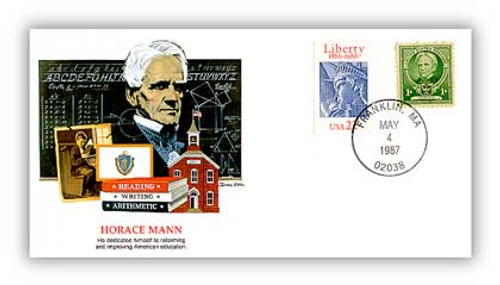
# 81869 - 1987 Walter Reed/Shapers of Am. Liberty
Dr. Walter Reed
Major Walter Reed, M.D., was born on September 13, 1851, in Belroi, Gloucester County, Virginia.
Reed spent his childhood in Murfreesboro, North Carolina with his mother and her family while his father, a traveling Methodist minister, went on speaking tours. Reed went on to attend the University of Virginia and received his M.D. degree two months before his 18th birthday, making him the youngest-ever recipient of that degree from that university.
Reed went on to earn a second M.D. from New York University’s Bellevue Hospital Medical College in 1870. He then worked for the New York Board of Health until 1875. Unhappy with his position, he decided to join the US Army Medical Corps. After passing a 30-hour examination, he was enlisted to the medical corps as an assistant surgeon.
Reed spent the next 16 years at various outposts taking care of American military troops and their families as well as Native American tribes. At one point he cared for several hundred Apaches, including Geronimo. Working in these outposts, Reed witnessed unsanitary conditions and decided to study pathology and bacteriology as well.
Reed went on to join the staff of the George Washington University School of Medicine the Army Medical School in Washington, DC, in 1893. There he served as professor of Bacteriology and Clinical Microscopy. In addition to teaching, he also worked on medical research projects and curated the Army Medical Museum.
In 1896, Reed earned significant recognition for his work as a medical investigator. At the time, enlisted men near the Potomac River were inflicted with yellow fever. Some thought it was from drinking the river water. But Reed discovered it was because they had been hiking through the local swampy woods at night.
Reed was then dispatched to Cuba to investigate the typhoid fever epidemic among US Army soldiers fighting in the Spanish-American War. His studies showed that it was the unsanitary conditions, especially in the field hospitals, that spread the infection.
In 1900, Reed returned to Cuba to study tropical diseases. Through his study of yellow fever (based largely on the work of Carlos Finlay), it was determined the disease was transmitted by mosquitoes and not by contact with those who were sick with the disease. Reed’s findings helped reduce the number of yellow fever cases. They discovered not only that a certain mosquito carried the disease, they also developed a treatment. He made it possible to build the Panama Canal without the large loss of life that the French suffered when they attempted to construct a canal 20 years before.
Upon returning to the US, Reed spoke and wrote about yellow fever and received honorary degrees from Harvard and the University of Michigan. He died on November 22, 1902 due to complications from a ruptured appendix.
In the years since his death, many things have been named in his honor – an award, a tropical medicine course, and several medical centers.
Dr. Walter Reed
Major Walter Reed, M.D., was born on September 13, 1851, in Belroi, Gloucester County, Virginia.
Reed spent his childhood in Murfreesboro, North Carolina with his mother and her family while his father, a traveling Methodist minister, went on speaking tours. Reed went on to attend the University of Virginia and received his M.D. degree two months before his 18th birthday, making him the youngest-ever recipient of that degree from that university.
Reed went on to earn a second M.D. from New York University’s Bellevue Hospital Medical College in 1870. He then worked for the New York Board of Health until 1875. Unhappy with his position, he decided to join the US Army Medical Corps. After passing a 30-hour examination, he was enlisted to the medical corps as an assistant surgeon.
Reed spent the next 16 years at various outposts taking care of American military troops and their families as well as Native American tribes. At one point he cared for several hundred Apaches, including Geronimo. Working in these outposts, Reed witnessed unsanitary conditions and decided to study pathology and bacteriology as well.
Reed went on to join the staff of the George Washington University School of Medicine the Army Medical School in Washington, DC, in 1893. There he served as professor of Bacteriology and Clinical Microscopy. In addition to teaching, he also worked on medical research projects and curated the Army Medical Museum.
In 1896, Reed earned significant recognition for his work as a medical investigator. At the time, enlisted men near the Potomac River were inflicted with yellow fever. Some thought it was from drinking the river water. But Reed discovered it was because they had been hiking through the local swampy woods at night.
Reed was then dispatched to Cuba to investigate the typhoid fever epidemic among US Army soldiers fighting in the Spanish-American War. His studies showed that it was the unsanitary conditions, especially in the field hospitals, that spread the infection.
In 1900, Reed returned to Cuba to study tropical diseases. Through his study of yellow fever (based largely on the work of Carlos Finlay), it was determined the disease was transmitted by mosquitoes and not by contact with those who were sick with the disease. Reed’s findings helped reduce the number of yellow fever cases. They discovered not only that a certain mosquito carried the disease, they also developed a treatment. He made it possible to build the Panama Canal without the large loss of life that the French suffered when they attempted to construct a canal 20 years before.
Upon returning to the US, Reed spoke and wrote about yellow fever and received honorary degrees from Harvard and the University of Michigan. He died on November 22, 1902 due to complications from a ruptured appendix.
In the years since his death, many things have been named in his honor – an award, a tropical medicine course, and several medical centers.







